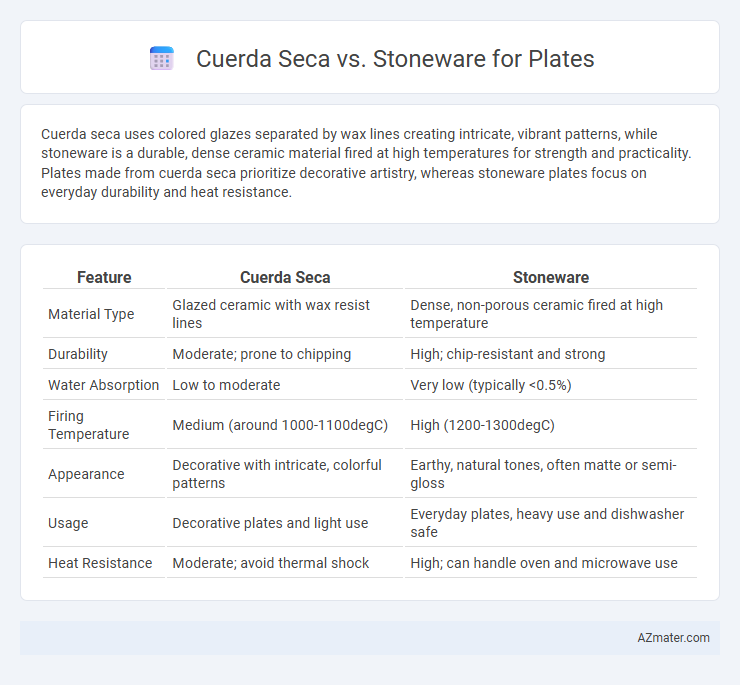Cuerda seca uses colored glazes separated by wax lines creating intricate, vibrant patterns, while stoneware is a durable, dense ceramic material fired at high temperatures for strength and practicality. Plates made from cuerda seca prioritize decorative artistry, whereas stoneware plates focus on everyday durability and heat resistance.
Table of Comparison
| Feature | Cuerda Seca | Stoneware |
|---|---|---|
| Material Type | Glazed ceramic with wax resist lines | Dense, non-porous ceramic fired at high temperature |
| Durability | Moderate; prone to chipping | High; chip-resistant and strong |
| Water Absorption | Low to moderate | Very low (typically <0.5%) |
| Firing Temperature | Medium (around 1000-1100degC) | High (1200-1300degC) |
| Appearance | Decorative with intricate, colorful patterns | Earthy, natural tones, often matte or semi-gloss |
| Usage | Decorative plates and light use | Everyday plates, heavy use and dishwasher safe |
| Heat Resistance | Moderate; avoid thermal shock | High; can handle oven and microwave use |
Introduction to Cuerda Seca and Stoneware Plates
Cuerda seca is a traditional ceramic glazing technique characterized by its use of oily resist lines to separate vibrant color glazes, creating intricate and durable decorative patterns on plates. Stoneware plates are high-fired ceramics, known for their dense, non-porous nature and exceptional strength, making them highly resistant to chipping and suitable for everyday use. The choice between cuerda seca and stoneware plates depends on whether the priority is artistic detail and historical craftsmanship or practicality and durability.
Historical Background of Cuerda Seca and Stoneware
Cuerda seca, a decorative ceramic technique originating in Islamic Spain during the 10th century, involves using waxy resist lines to separate colored glazes, producing intricate, multi-colored tile and plate designs. Stoneware, dating back to ancient China around 1600 BCE, is a durable, non-porous ceramic fired at high temperatures, widely used for functional tableware throughout history. Both techniques highlight significant cultural and technological advancements in ceramic artistry, with cuerda seca emphasizing vibrant, decorative patterns and stoneware focusing on strength and utility.
Key Differences in Manufacturing Processes
Cuerda seca plates utilize a unique technique where a greasy, resistive substance is applied to create color-separated designs before glazing, preventing colors from running into each other during firing. Stoneware plates are crafted from a dense, non-porous clay fired at high temperatures, resulting in durable, vitrified pottery without the need for color resist methods. The primary manufacturing difference lies in cuerda seca's decorative resist application versus stoneware's focus on clay composition and high-temperature firing for strength.
Material Composition and Durability Comparison
Cuerda seca ceramics utilize a mixture of clay with metal oxides and mineral pigments that are separated by wax-resist lines, resulting in vibrant, intricate designs sealed under a transparent glaze; this technique offers moderate durability but is more prone to chipping due to the delicate glaze application. Stoneware is composed primarily of refined clay fired at high temperatures (typically 1,200-1,300degC), creating a dense, non-porous material with superior strength and resistance to thermal shock, making it highly durable for everyday plate use. The material composition of stoneware ensures greater longevity and mechanical resistance compared to the decorative but more fragile cuerda seca technique.
Aesthetic Appeal: Colors, Patterns, and Textures
Cuerda seca technique offers vibrant, intricate patterns with a distinct separation of colors achieved by a waxy resist, resulting in bold and highly detailed designs on plates. Stoneware plates, in contrast, emphasize earthy, natural textures and muted tones that highlight the material's organic appeal and durability. While cuerda seca provides vivid and complex aesthetics rich in cultural motifs, stoneware presents a rustic, understated elegance with smooth or slightly rough surfaces that enhance tactile experience.
Functional Uses in Everyday Dining
Cuerda seca technique creates intricate, multi-colored designs on ceramic plates, making them ideal for decorative serving and special occasions due to their delicate glaze and hand-painted details. Stoneware plates offer superior durability and resistance to chipping, making them perfect for daily use, microwave heating, and dishwasher cleaning without compromising functionality. Choosing between cuerda seca and stoneware depends on whether aesthetic appeal or practical durability is prioritized for everyday dining.
Maintenance and Cleaning Requirements
Cuerda seca plates require gentle cleaning with mild soap and a soft cloth to prevent damaging the intricate glazes, while avoiding prolonged soaking to maintain their vibrant colors. Stoneware plates are more durable and dishwasher-safe, allowing for easier maintenance with standard cleaning methods and resistance to staining. Choosing stoneware offers practical convenience in daily use, whereas cuerda seca demands careful handling to preserve its decorative finish.
Cost and Accessibility in the Market
Cuerda seca ceramics often have higher production costs due to intricate glazing techniques and limited artisan availability, resulting in premium market prices. Stoneware plates are more widely accessible and affordable, benefiting from mass production capabilities and established supply chains. Consumers seeking budget-friendly and readily available dinnerware frequently prefer stoneware over the niche cuerda seca style.
Suitability for Artistic and Custom Designs
Cuerda seca techniques allow for intricate, multicolored patterns ideal for artistic and custom ceramic plate designs, offering precise color separation and vibrant detail. Stoneware, known for its durability and subtle earth tones, provides a sturdy canvas but lacks the vivid color contrasts achievable with cuerda seca. For artists seeking intricate, colorful motifs, cuerda seca is more suitable, while stoneware suits designs emphasizing texture and natural aesthetics.
Choosing the Right Plate: Cuerda Seca or Stoneware?
Choosing the right plate between cuerda seca and stoneware depends on your aesthetic preference and durability needs. Cuerda seca plates feature intricate, colorful patterns achieved through a resist-painting technique, making them ideal for decorative use and serving light meals. Stoneware plates offer superior strength, chip resistance, and heat retention, making them practical for everyday dining and heavy-duty use.

Infographic: Cuerda seca vs Stoneware for Plate
 azmater.com
azmater.com